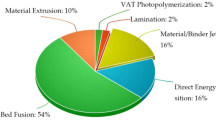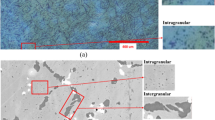Abstract
In additive manufacturing (AM), internal flaws that form during processing can have a detrimental impact on the resulting fatigue behavior of the component. Nondestructive x-ray computed tomography (XCT) has been routinely used to inspect AM components. This technique, however, is limited by what is resolvable as well as the automated procedures available to analyze the data. In this study, we compared XCT scans and automated flaw recognition analysis of the corresponding data to results obtained from an automated mechanical polishing-based serial sectioning system. Although internal porosity and surface roughness were easily observed by serial sectioning with bright-field optical microscopy, the same level of information could not be obtained from the XCT data. For the acquisition parameters used, XCT had only a 15.7% detection rate compared to that of serial sectioning. The results point to the need to recognize the limitations of XCT and for supplementary XCT scan quality metrics in addition to the voxel size.





Similar content being viewed by others
Change history
14 April 2021
A Correction to this paper has been published: https://doi.org/10.1007/s11665-021-05749-6
References
T. DebRoy et al., Scientific, Technological and Economic Issues in Metal Printing and Their Solutions, Nat. Mater., 2019, 18(10), p 1026–1032. https://doi.org/10.1038/s41563-019-0408-2
M. Javaid and A. Haleem, Additive Manufacturing Applications in Medical Cases: A Literature Based Review, Alex. J. Med., 2018, 54(4), p 411–422. https://doi.org/10.1016/j.ajme.2017.09.003
Wohlers Associates, Wohler Report-3D Printing and Additive Manufacturing State of the Industry Annual Worldwide Progress Report, Wohlers Associates Inc, Fort Collins, 2018.
P. Edwards, A. O’Conner and M. Ramulu, Electron Beam Additive Manufacturing of Titanium Components: Properties and Performance, J. Manuf. Sci. Eng., 2013, 135(6), p 061016–0610167. https://doi.org/10.1115/1.4025773
S. Tammas-Williams, P.J. Withers, I. Todd and P.B. Prangnell, The Influence of Porosity on Fatigue Crack Initiation in Additively Manufactured Titanium Components, Sci. Rep., 2017, 7(1), p 1–13. https://doi.org/10.1038/s41598-017-06504-5
H. Masuo et al., Influence of Defects, Surface Roughness and HIP on the Fatigue Strength of Ti-6Al-4V Manufactured by Additive Manufacturing, Int. J. Fatigue, 2018, 117, p 163–179. https://doi.org/10.1016/j.ijfatigue.2018.07.020
Q.Y. Lu and C.H. Wong, Additive Manufacturing Process Monitoring and Control by Non-Destructive Testing Techniques: Challenges and In-Process Monitoring, Virtual Phys. Prototyp., 2018, 13(2), p 39–48. https://doi.org/10.1080/17452759.2017.1351201
A. Thompson, I. Maskery and R.K. Leach, X-ray Computed Tomography for Additive Manufacturing: A Review, Meas. Sci. Technol., 2016, 27(7), p 072001–072001. https://doi.org/10.1088/0957-0233/27/7/072001
S.G. Lee and A.M. Gokhale, Formation of Gas Induced Shrinkage Porosity in Mg-Alloy High-Pressure Die-Castings, Scr. Mater., 2006, 55(4), p 387–390. https://doi.org/10.1016/j.scriptamat.2006.04.040
G. Nicoletto, R. Konečná and S. Fintova, Characterization of Microshrinkage Casting Defects of Al-Si Alloys by X-ray Computed Tomography and Metallography, Int. J. Fatigue, 2012, 41, p 39–46. https://doi.org/10.1016/j.ijfatigue.2012.01.006
M.A. Groeber, E. Schwalbach, S. Donegan, K. Chaput, T. Butler and J. Miller, Application of Characterization, Modelling, and Analytics Towards Understanding Process-Structure Linkages in Metallic 3D Printing, IOP Conf. Ser. Mater. Sci. Eng., 2017, 219, p 012002. https://doi.org/10.1088/1757-899X/219/1/012002
S. Everton, P. Dickens, C. Tuck, B. Dutton, D. Wimpenny, The Use of Laser Ultrasound to Detect Defects in Laser Melted Parts, in TMS 2017 146th Annual Meeting and Exhibition Supplemental Proceedings, T. M. Tms Metals &. Materials So, Ed. Springer, Cham, pp. 105–116
I. Hakim et al., Volume Imaging NDE and Serial Sectioning of Carbon Fiber Composites, Provo, Utah, USA, , p. 120003. doi: https://doi.org/10.1063/1.5031590.
J.E. Spowart, Automated Serial Sectioning for 3-D Analysis of Microstructures, Scr. Mater., 2006, 55(1), p 5–10. https://doi.org/10.1016/j.scriptamat.2006.01.019
M. Seifi, I. Ghamarian, P. Samimi, U. Ackelid, P. Collins, and J. Lewandowski, “Microstructure and Mechanical Properties of Ti-48Al-2Cr-2Nb Manufactured Via Electron Beam Melting,” in Proceedings of the 13th World Conference on Titanium, Hoboken, NJ, USA, May 2016, pp. 1317–1322. doi: https://doi.org/10.1002/9781119296126.ch223.
D.J. Rowenhorst, L. Nguyen, A.D. Murphy-Leonard and R.W. Fonda, Characterization of Microstructure in Additively Manufactured 316L Using Automated Serial Sectioning, Curr. Opin. Solid State Mater. Sci., 2020, 24(3), p 100819. https://doi.org/10.1016/j.cossms.2020.100819
ASTM International. B348/B348M-19 Standard Specification for Titanium and Titanium Alloy Bars and Billets. West Conshohocken, PA; ASTM International, 2019. https://doi.org/10.1520/B0348_B0348M-19.
C. Gobert, E.W. Reutzel, J. Petrich, A.R. Nassar and S. Phoha, Application of Supervised Machine Learning for Defect Detection During Metallic Powder Bed Fusion Additive Manufacturing Using High Resolution Imaging, Addit. Manuf., 2018, 21, p 517–528. https://doi.org/10.1016/j.addma.2018.04.005
A. Jillavenkatesa, S.J. Dapkunas and L.-S.H. Lum, Particle Size Characterization, Vol 960 National Institute of Standards and Technology, Gaithersburg, 2001.
C. Gobert, A. Kudzal, J. Sietins, C. Mock, J. Sun and B. McWilliams, Porosity Segmentation in X-ray Computed Tomography Scans of Metal Additively Manufactured Specimens with Machine Learning, Addit. Manuf., 2020, 36, p 101460. https://doi.org/10.1016/j.addma.2020.101460
A. du Plessis et al., Laboratory X-ray Tomography for Metal Additive Manufacturing: Round Robin Test, Addit. Manuf., 2019, 30, p 100837. https://doi.org/10.1016/j.addma.2019.100837
R. Biswal et al., Interrupted Fatigue Testing with Periodic Tomography to Monitor Porosity Defects in Wire + Arc Additive Manufactured Ti-6Al-4V, Addit. Manuf., 2019, 28, p 517–527. https://doi.org/10.1016/j.addma.2019.04.026
F.H. Kim, A.L. Pintar, S.P. Moylan and E.J. Garboczi, The Influence of X-ray Computed Tomography Acquisition Parameters on Image Quality and Probability of Detection of Additive Manufacturing Defects, J. Manuf. Sci. Eng., 2019, 141(11), p 111002. https://doi.org/10.1115/1.4044515
ASTM International. E1570-19 Standard Practice for Fan Beam Computed Tomographic (CT) Examination. West Conshohocken, PA; ASTM International, 2019.https://doi.org/10.1520/E1570-19
ASTM International. E1695-20 Standard Test Method for Measurement of Computed Tomography (CT) System Performance. West Conshohocken, PA; ASTM International, 2020. https://doi.org/10.1520/E1695-20
Acknowledgment
The authors would like to acknowledge the Office of Naval Research Manufacturing Technology program and the Applied Research Laboratory’s Institute for Manufacturing and Sustainment Technologies, which is funded under the Naval Sea Systems Command (NAVSEA) contract #N00024-12-D-6404, as well as UES SBIR, Phase I Z4.05-6355, NASA Contract: 80NSSC20C0360. The authors also wish to thank the Center for Innovative Materials Processing through Direct Digital Deposition (CIMP-3D) for the use of their equipment and laboratory facilities.
Author information
Authors and Affiliations
Corresponding author
Additional information
Publisher's Note
Springer Nature remains neutral with regard to jurisdictional claims in published maps and institutional affiliations.
This invited article is part of a special topical focus in the Journal of Materials Engineering and Performance on Additive Manufacturing. The issue was organized by Dr. William Frazier, Pilgrim Consulting, LLC; Mr. Rick Russell, NASA; Dr. Yan Lu, NIST; Dr. Brandon D. Ribic, America Makes; and Caroline Vail, NSWC Carderock.
Rights and permissions
About this article
Cite this article
Sundar, V., Snow, Z., Keist, J. et al. Flaw Identification in Additively Manufactured Parts Using X-ray Computed Tomography and Destructive Serial Sectioning. J. of Materi Eng and Perform 30, 4958–4964 (2021). https://doi.org/10.1007/s11665-021-05567-w
Received:
Revised:
Accepted:
Published:
Issue Date:
DOI: https://doi.org/10.1007/s11665-021-05567-w




